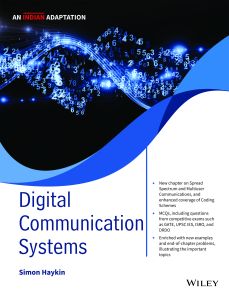Digital Communication Systems, An Indian Adaptation
ISBN: 9789354242465
652 pages
Publication Year: 2021
For more information write to us at: acadmktg@wiley.com

Description
Digital Communication Systems is a comprehensive textbook, focusing on the core principles of digital communications and relating theory to practice. Starting with the background of Fourier analysis, probability theory, and stochastic processes to analyze random signals, the book covers sampling theory, pulse-amplitude modulation, pulse-code modulation, delta modulation, matched filter, intersymbol interference, and adaptive equalization. It then discusses passband digital modulation techniques such as ASK, PSK, FSK, and QAM, followed by multiple access techniques such as FDMA, TDMA, and CDMA. Lastly, it discourses on information theory in detail and various coding schemes to control the occurrences of errors in communication systems.
Chapter 1: Introduction
- Historical Background
- The Communication Process
- Modes of Communication
- Need of Modulation
- Types of Modulation
- Digital versus Analog Communication
- Multiple-Access Techniques
- Networks
- Digital Communication
- Self-Sustainable Modern Communication
- Organization of the Book
Chapter 2: Frequency Analysis And Transmission Of Signals
- Introduction
- Representation of a Signal
- The Fourier Series
- The Fourier Transform
- The Inverse Relationship between Time-Domain and Frequency-Domain Representations
- The Dirac Delta Function
- Fourier Transforms of Periodic Signals
- Correlation of Signals
- Transmission of Signals through Linear Time-Invariant Systems
- Ideal Filters
- Hilbert Transform
- Pre-Envelopes
- Complex Envelopes of Band-Pass Signals
- Canonical Representation of Band-Pass Signals
- Complex Low-Pass Representations of Band-Pass Systems
- Putting the Complex Representations of Band-Pass Signals and Systems All Together
- Linear Modulation Theory
- Superheterodyne Receiver
- Phase and Group Delays
- Exponential (or Angle) Modulation
- Summary and Discussion
Chapter 3: Probability Theory And Random Variables
- Introduction
- Set Theory
- Probability Theory
- Random Variables
- Distribution Functions
- The Concept of Expectation
- Second-Order Statistical Averages
- The Gaussian Distribution
- The Central Limit Theorem
- Functions of One Random Variable
- Functions of Two Random Variables
- Bayesian Inference
- Parameter Estimation
- Hypothesis Testing
- Composite Hypothesis Testing
- Summary and Discussion
Chapter 4: Stochastic Processes
- Introduction
- Mathematical Definition of a Stochastic Process
- Two Classes of Stochastic Processes: Strictly Stationary and Weakly Stationary
- Mean, Correlation

